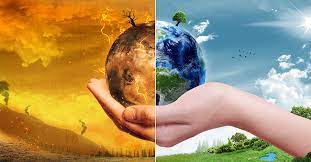
What is the difference between climate change and global warming?
Climate change and global warming are terms that you might have heard often in the news.
But what do they mean? And how do they differ from each other?
In this article, we'll explain the difference between climate change and global warming in simple terms.
Impacts of Climate Change and Global Warming on the Environment
The impacts of climate change and global warming on the environment are profound and multifaceted.
Rising global temperatures associated with global warming contribute to a range of environmental changes, which in turn amplify the effects of climate change. These impacts affect ecosystems, biodiversity, natural resources, and human livelihoods in various ways.
One of the primary impacts of global warming is the melting of polar ice caps and glaciers. As temperatures rise, ice sheets in the Arctic and Antarctic regions experience accelerated melting, leading to rising sea levels.
This, in turn, poses significant threats to coastal communities and low-lying areas, increasing the risk of flooding and erosion.
Furthermore, climate change and global warming disrupt ecosystems and biodiversity. Shifts in temperature and precipitation patterns can alter habitats, affecting the distribution and behavior of species.
Many plants and animals face challenges as they struggle to adapt to these rapid changes, leading to reduced biodiversity and potential ecosystem collapse.
Additionally, climate change exacerbates extreme weather events such as hurricanes, droughts, and heatwaves. These events can have devastating consequences for communities, causing loss of life, property damage, and disruptions to infrastructure and essential services.
Main differences between climate change and global warming
Climate change and global warming are often used interchangeably but have distinct meanings.
Climate change is a broader term that encompasses global warming, as well as other changes in climate patterns.
Global warming refers to the planet's temperature rising due to increased levels of greenhouse gasses in the atmosphere. The resulting increase in average global temperature is one way climate scientists measure whether we're experiencing these changes to our climate systems.
Global warming refers to the planet's temperature rising, while climate change includes a broader range of changes that are happening to our planet.
Climate change may or may not include a rise in temperatures; if there is no increase in average temperature but other climatic conditions are changing (such as precipitation or wind patterns), then we can say that there has been an observable impact from human activities on climate change even though it doesn't fit neatly into our definition of "global warming."
Global warming is caused by human activities such as burning fossil fuels, while climate change can be caused by both human and natural activities.
When you hear "climate change," you may think of a warm planet that is steadily getting hotter. But climate change refers to any significant change in the climate over time, whether that's due to natural causes or human activities.
Global warming describes one specific type of climate change: the increase in temperature of Earth's atmosphere and oceans since the late 19th century.
The term was popularized by John F. Kennedy in a 1963 speech at American University:
"The depletion of our fossil fuels and other precious minerals could create a major crisis for mankind."
Understanding the Relationship: Climate Change and Global Warming
Understanding the relationship between climate change and global warming is crucial in comprehending the complexities of these phenomena.
While the terms are often used interchangeably, it is important to recognize their distinct meanings and how they relate to each other.
Climate change is a broader concept that encompasses various changes in climate patterns, including global warming.
Global warming specifically refers to the increase in the Earth's temperature caused by the buildup of greenhouse gases in the atmosphere. It is a significant component of climate change, as rising global temperatures have far-reaching impacts on our planet's ecosystems, weather patterns, and human activities.
However, climate change encompasses more than just rising temperatures. It includes shifts in precipitation patterns, wind patterns, sea levels, and other climatic variables.
The relationship between climate change and global warming can be understood as follows: global warming is a subset of climate change. The increase in global temperatures is a notable consequence of climate change, but it is not the only change occurring.
By recognizing this relationship, we can appreciate the broader implications of climate change beyond temperature increases alone.
The Role of Human Activities in Climate Change and Global Warming
Human activities play a significant role in driving both climate change and global warming. The burning of fossil fuels, deforestation, industrial processes, and agricultural practices are among the primary contributors to the increase in greenhouse gas emissions, leading to global warming.
The combustion of fossil fuels, such as coal, oil, and natural gas, releases carbon dioxide (CO2) and other greenhouse gases into the atmosphere. These gases trap heat, creating the greenhouse effect and resulting in the warming of the Earth's surface.
Deforestation also contributes to climate change. Trees absorb CO2 as part of their natural lifecycle, acting as carbon sinks.
However, widespread deforestation reduces the number of trees available to absorb CO2, leading to increased concentrations of greenhouse gases in the atmosphere.
Furthermore, industrial processes release greenhouse gases such as methane (CH4) and nitrous oxide (N2O), which have a more potent warming effect than CO2. Agricultural practices, including livestock farming and rice cultivation, also generate significant amounts of methane and nitrous oxide.
It is essential to recognize the role of human activities in climate change and global warming to address these issues effectively. By transitioning to cleaner energy sources, promoting sustainable land use practices, and adopting climate-friendly technologies, we can mitigate the impacts of climate change and work towards a more sustainable future.
Conclusion
So the next time someone asks you what the difference is between climate change and global warming, you can tell them that they are two different things with similar consequences. Both of these phenomena threaten human health, so it's important to take action now before it's too late!















